1905 – The Beginning of the End
| < 1903 – Rosyth | Δ Index | 1906 – The end of the Submarine Mining Service > |
Having installed the gun batteries, searchlights, barracks and a permanent submarine mining Station all to beef up the defences of the Forth and protect the planned Royal Navy Dockyard at Rosyth it seemed like the Submarine Miners would have a rosy future with new improved facilities; but there were clouds on the horizon.
There was a feeling that as the submarine mines in the Forth would soon be protecting a naval base; the use of a Volunteer Force might lead to security issues.
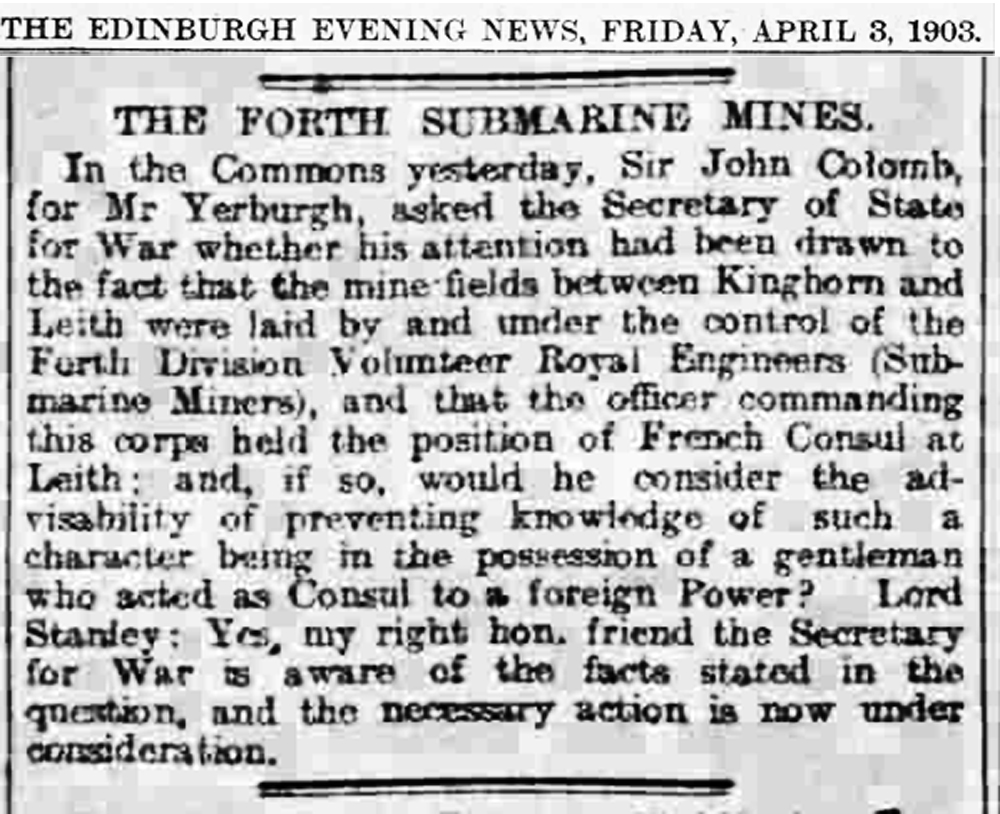
There was also a feeling that the concept of submarine mines might be out-moded.
19th century naval arms race
When the Submarine Mining service was first established in the 1860s the state of the art in naval warfare was the Ironclad as represented here by HMS Warrior.
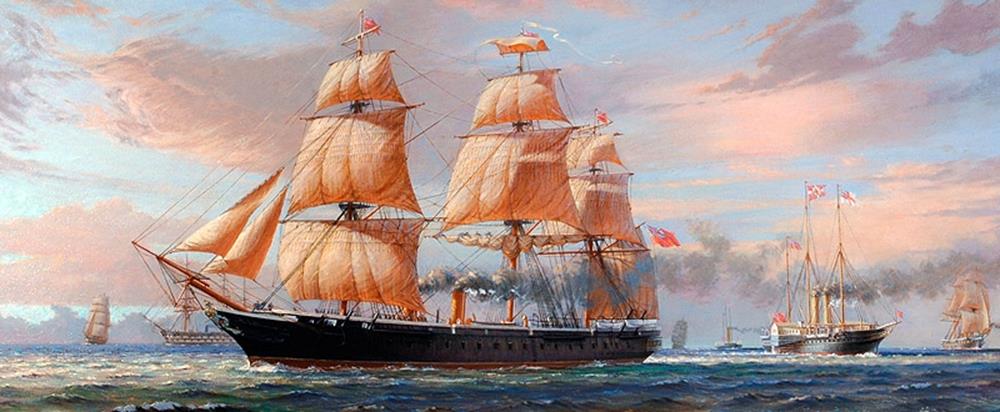
HMS Warrior – 1860
She was an evolution of the sailing ships which fought at Trafalgar in 1805, developed in response to similar innovations in the French Navy, adding steam power to sail, and an iron-cladding over her wooden hull. Armament was still side-facing gun-ports, she would engage the enemy at close quarters and exchange broadsides.
Pre-dreadnoughts
By the 1890s sail had given way to steam, and a new class of battleship was introduced.
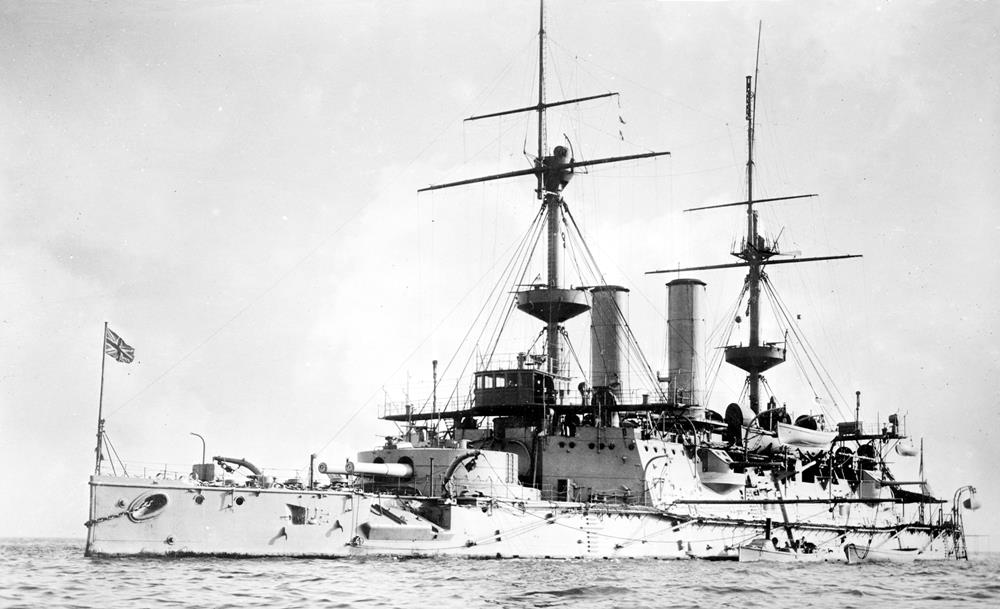
HMS Hood of 1891
Built from steel, and protected by hardened steel armour, pre-dreadnought battleships carried a main battery of very heavy guns in barbettes supported by one or more secondary batteries of lighter weapons. The heavy guns could penetrate the armour plating of enemy ships at a range of up to 5,000 yards. The ships were powered by coal-fuelled triple-expansion steam engines.
In contrast to the chaotic development of ironclad warships in preceding decades, the 1890s saw navies worldwide start to build battleships to a common design as dozens of ships essentially followed the design of the British Majestic class. The similarity in appearance of battleships in the 1890s was underlined by the increasing number of ships being built. New naval powers such as Germany, Japan, the United States, and to a lesser extent Italy and Austria-Hungary, began to establish themselves with fleets of pre-dreadnoughts, while the navies of Britain, France, and Russia expanded to meet these new threats.
The Dreadnoughts

HMS Dreadnought was a battleship built for the Royal Navy that revolutionised naval power. Dreadnought’s entry into service in 1906 represented such an advance in naval technology that its name came to be associated with an entire generation of battleships, the “dreadnoughts”, as well as the class of ships named after it.
The dreadnoughts made all previous generations of ships obsolete. Admiral Sir John “Jacky” Fisher, First Sea Lord of the Board of Admiralty, is credited as the father of Dreadnought. Shortly after he assumed office in 1904, he ordered design studies for a battleship armed solely with 12-inch (305 mm) guns and a speed of 21 knots (39 km/h; 24 mph).
Dreadnought was the first battleship of her era to have a uniform main battery, rather than having a few large guns complemented by a heavy secondary armament of smaller guns. She was also the first capital ship to be powered by steam turbines, making her the fastest battleship in the world at the time of her completion. Her launch helped spark a naval arms race as navies around the world, particularly the German Imperial Navy, rushed to match it in the build-up to World War I.
Her guns had a range of 16,000 yards, so she could sit off-shore and bombard targets far from the dangers of a minefield.
Underwater Weapons
Despite the usefulness of submarine mines in the American Civil War and elsewhere, the Royal Navy was not in favour of the use of “infernal machines” – mines and torpedoes.
For decades the navy wrestled with a dilemma – should it adopt underwater weapons for its own use, or simply develop counter-measures to these “un-British” weapons?
Allan Cowpe’s PhD thesis Underwater weapons and the Royal Navy 1869 to 1918 explores the evolution in naval strategy regarding these weapons.
Submarine mines were adopted by the navy to guard their ships while in remote locations – e.g. coaling stations – but Naval officers displayed a half-fearful, half contemptuous dislike of the idea of mines. The immense labours involved never seemed to justify the results, which were anything but spectacular. There were limited practice exercises, so proficiency was never achieved.
The other underwater weapon – the torpedo – was also viewed with suspicion. It was certainly effective – an underwater explosion was likely to sink a ship, especially as battleships were lightly armoured below the waterline, but it was costly device, had limited range, required special training to operate, and was difficult to launch from a battleship.
Small torpedo boats made launching simpler, and could operate close to enemy shipping, but because they were small, they could not cruise long distances in high seas as part of a fleet of battleships.
The solution to this dilemma was the submarine.
Submarines
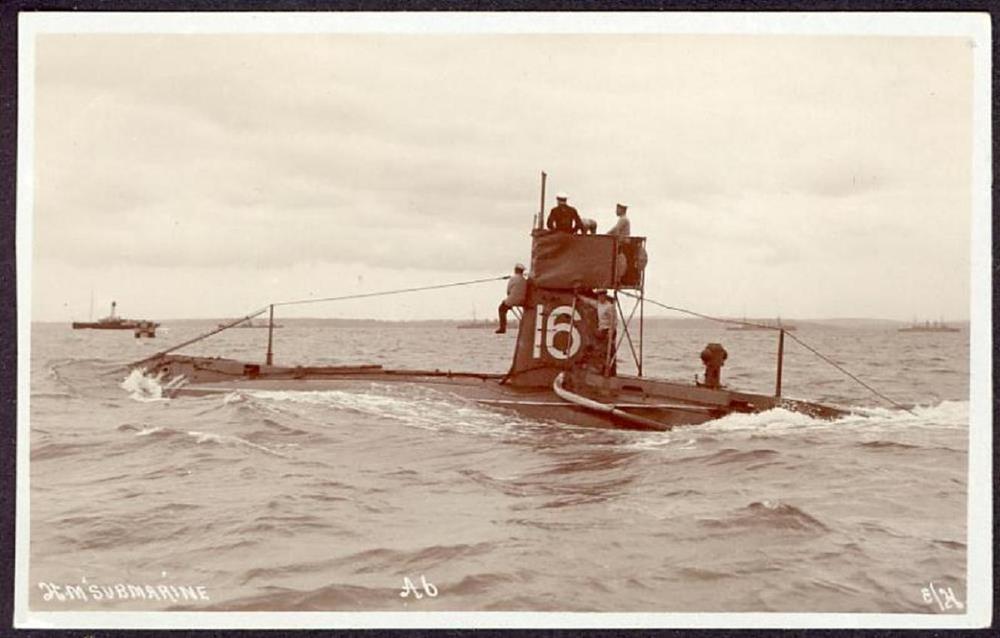
The submarine could operate over long distances, and while submerged could approach enemy shipping within torpedo range, launch an attack and retreat unobserved.
In 1902 the first British submarine was launched, an American Holland class design. A series of new designs followed in the years up to WWI.
From being sceptical about underwater weapons, the navy now decided to embrace them. The submarine boats would assume responsibility for all underwater weapons – torpedoes and mines.
The last camp at North Queensferry was held in 1905
1905 The last Camp at North Queensferry
This was practically my last year as a Volunteer. I succeeded to the command of the Corps after Lt Col Salvesen retired in end of 1904. In beginning of 1905 intimation was sent us that submarine mining by land forces was to be abolished and all stores handed over to the Navy. It was not stated what was to become of the personnel of the various corps and pending instructions from the War Office as to our final destination we held our annual training at North Queensferry, and practised various useful subjects including running the electric searchlights outside the Forth Bridge, shelter trench work and signalling. I was complimented on the condition of the corps by the Inspecting Officer Col. Hippisley CB RE and the following notice appeared in the newspaper
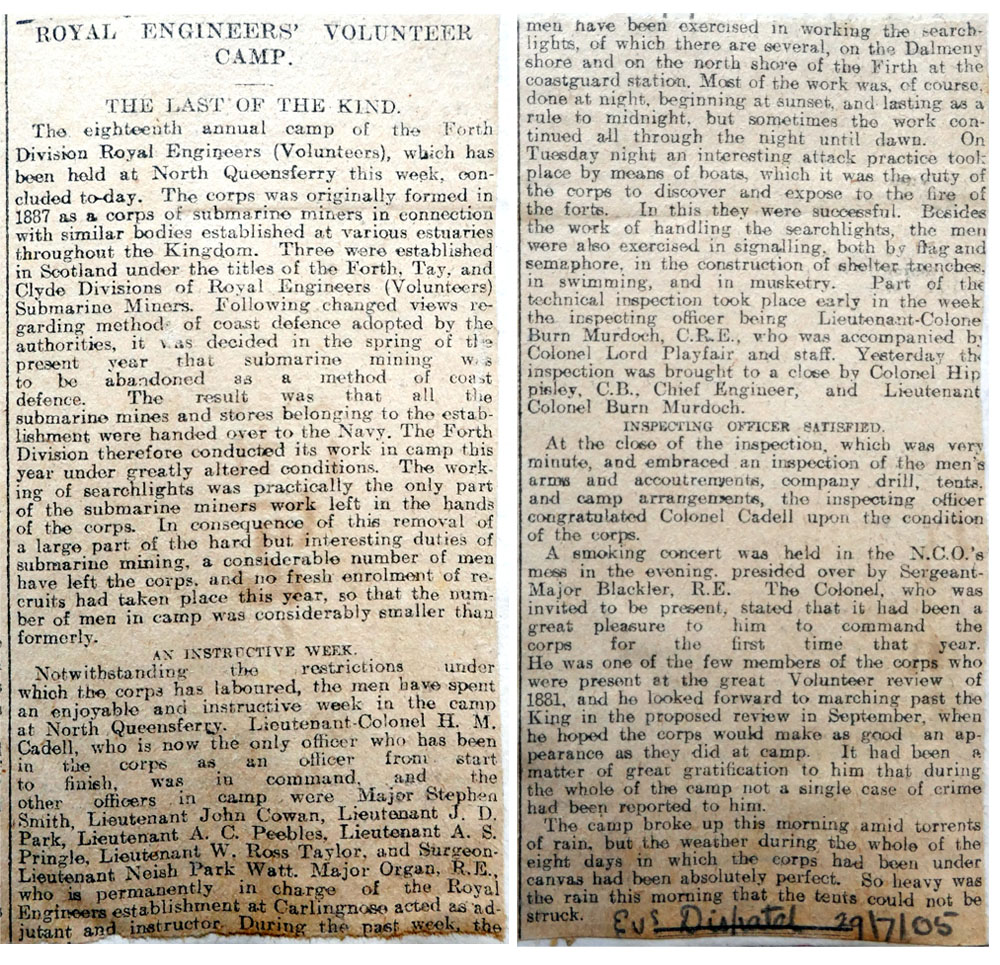
ROYAL ENGINEERS’ VOLUNTEER CAMP
THE LAST OF THE KIND
The eighteenth annual camp of the Forth Royal Engineers (Volunteers), which has been held at North Queensferry this week, concluded today. The corps was originally formed in 1887 as a corps of submarine miners in connection with similar bodies established at various estuaries throughout the Kingdom. Three were established in Scotland under the titles of Forth, Tay and Clyde Divisions of Royal Engineers (Volunteers) Submarine Miners. Following changed views regarding methods of coast defence adopted by the authorities, it was decided in the spring of the present year that submarine mining was to be abandoned as a method of coast defence. The result was that all the submarine mines and stores belonging to the establishment were to be handed over to the Navy. The Forth Division therefore conducted its work in camp this year under greatly altered conditions. The working of searchlights was practically the only part of the submarine miners work left in the hands of the corps. In consequence of this removal of the hard but interesting duties of submarine mining, a considerable number of men have left the corps, and no fresh enrolment of recruits had taken place this year, so that the numbers of men in camp was considerably smaller than formerly.
AN INSTRUCTIVE WEEK
Notwithstanding the restrictions under which the corps has laboured, the men have spent an enjoyable time and instructive week in North Queensferry. Lieutenant Colonel H. M. Cadell, who is now the only officer who has been in the corps from start to finish was in command and the other officers in camp were Major Stephen Smith, Lieutenant John Cowan, Lieutenant A. C. Peebles, Lieutenant A. S. Pringle, Lieutenant W. Ross Taylor, and Surgeon-Lieutenant Neish Park Watt. Major Organ, R.E. who is permanently in charge of the Royal Engineers establishment at Carlingnose acted as adjutant and instructor. During the past week, the men have been exercised in working the searchlights of which there are several on the Dalmeny shore and on the north shore of the Firth at the coastguard station. Most of the work was, of course done at night beginning at sunset and lasting as a rule till midnight, but sometimes the work continued all through the night until dawn. On Tuesday night an interesting attack practice took place by means of boats, which it was the duty of the corps to discover and expose to the fire of the forts. In this they were successful. Besides the work of handling the searchlights, the men were also exercised in signalling, both by flag and semaphore, in the construction of shelter trenches, in swimming and in musketry. Part of the technical inspection took place early in the week, the inspecting officer being Lieutenant-Colonel Burn Murdoch C.R.E., who was accompanied by Colonel Lord Playfair and staff. Yesterday the inspection was brought to a close by Colonel Hippisley, C.B., Chief Engineer, and Lieutenant Colonel Burn Murdoch.
INSPECTING OFFICER SATISFIED
At the close of the inspection, which was very minute, and embraced an inspection of the men’s arms and accoutrements, company drill, tents and camo arrangements, the inspecting officer congratulated Colonel Cadell upon the condition of the corps.
A smoking concert was held in the N.C.O.’s mess in the evening, presided over by Sergeant-Major Blackner, R.E. The Colonel, who was invited to be present, stated that it had been a great pleasure to him to command the corps for the first time that year. He was one of the few members of the corps who were present at the great Volunteer review of 1881, and he looked forward to marching past the King in the proposed review in September, when he hoped the corps would make as good an appearance as they did in camp. It had been a matter of great satisfaction that during the whole of the camp not a single case of crime had been reported to him.
The camp broke up this morning amid torrents of rain, but the weather during the whole of the eight days in which the corps had been under canvas had absolutely perfect. So heavy was the rain this morning that the tents could not be struck
Evening Dispatch – 29th July 1905
| < 1903 – Rosyth | Δ Index | 1906 – The end of the Submarine Mining Service > |